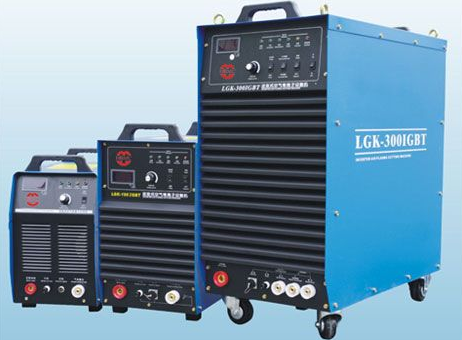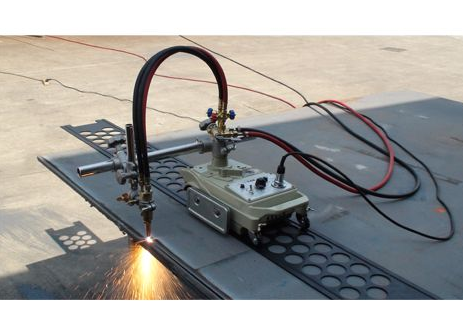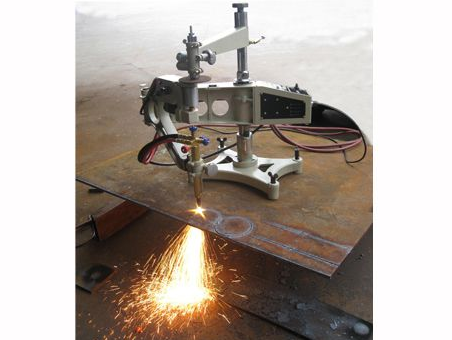The most common plasma cutting gases include air, hydrogen, oxygen, nitrogen, and argon. All five work well on thinner sheet metal (one-half inch or thinner), but plasma cutting manufacturers often use a combination of these gases to increase throughput when sheet thickness increases.
In addition to the thickness of the metal, its chemical properties and cut size also affect the plasma-cutting gas selection process.
The following are details of each plasma-cutting gas.
Compressed air
The most common type of plasma cutting machine gas used is air. Compressed air is versatile and inexpensive and is suitable for low current cutting and most metals (mild steel, stainless steel and aluminum) from gauge sizes to one inch thick.

Plasma Cutting Machine
One of the main advantages of compressed air is its low cost of purchase and storage. You can use it as a primary gas or auxiliary fuel source, and it leaves no particles behind when cutting metal.
Oxygen
Oxygen has become the gas of choice for cutting mild steel because it provides clean cuts and faster cutting speeds on carbon steel up to 1 ¼" thick. While not recommended for cutting stainless steel or aluminum, you can rely on high - When you use oxygen on carbon steel, quality cuts with a smooth surface and scum (mineral waste formed on the surface of molten metal) are easily removed from the kerf (the seam formed by cutting with a saw). Oxygen is used in combination with other secondary fuels.
Some disadvantages of oxygen include its cost and shortened life of consumables. It is not suitable for bright surfaces and is therefore ineffective on stainless steel and aluminum projects.
Nitrogen
Nitrogen is often chosen as the plasma-cutting gas for higher current systems and for cutting materials up to 3" thick. It produces high-quality cuts in most materials, including stainless and mild steel and aluminum. However, for thicker metals, it is best to use nitrogen air as an auxiliary gas. Alternatively, if you want to increase cutting speed and achieve a better finish, consider carbon dioxide as an auxiliary gas.
Nitrogen is abundant and available in the atmosphere, making it an inexpensive option. By itself, it is most effective on smooth, shiny, thin paper. However, you can use it with a variety of secondary gases, such as air, carbon dioxide and argon, to obtain thicker materials.

Gas Cutting Machine
Argon
Argon is a rare, inert gas that is relatively expensive but does not react with the metal it is cutting. The use of argon improves arc stability and protects the weld pool from atmospheric contamination. Although its high kinetic energy makes it an effective gas for plasma cutting, it cannot work alone due to its low electrical conductivity. Therefore, argon must be used in combination with a suitable auxiliary gas.
Hydrogen
In addition to being an excellent heat conductor, hydrogen has the properties needed to quickly cool hot metal surfaces. For these reasons, hydrogen is ideal for cutting aluminum and stainless steel. However, despite its excellent electrical conductivity, its low atomic weight prevents it from having high kinetic energy. Just like argon, it must be combined with other gases to produce a high intensity plasma flame.

CG2-150 Profiling Gas Cutter
Argon-hydrogen mixtures
Because they have very different properties, combining hydrogen and argon produces an excellent plasma-cutting flame. It uses a standard mixture of 65% argon and 35% hydrogen to produce the hottest plasma cutting flames and some of the cleanest cuts. Typically used for cutting stainless steel and aluminum, an argon and hydrogen mixture is required for cutting materials thicker than 3". It is also an ideal mixture for air planing almost any material.
Nitrogen Water Combination
The nitrogen-water plasma cutting gas mixture uses nitrogen as the primary gas and water as the secondary (protective) gas. The energy generated by the plasma gas breaks down the water in the torch into two components - hydrogen and oxygen. The hydrogen gas isolates the cutting zone from contamination, making the cut clean and free of dross and oxides.
Since it has been converted to its basic components, the water does not need to be treated. Water also helps reduce smoke and nitrogen oxide emissions. This economical plasma cutting gas mixture produces bright finishes on aluminum and stainless steel.








